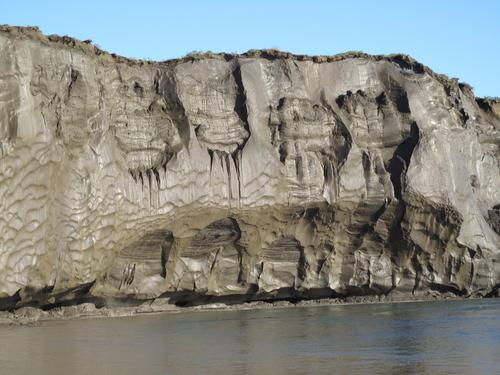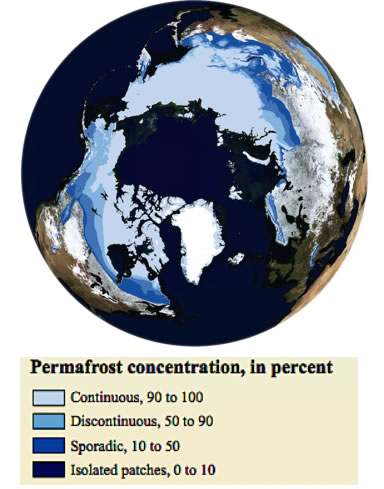Periglacial Processes and Landforms
Beyond the limits of glaciers lies a periglacial environment. A periglacial environment occurs in cold climates but not cold enough to permit the formation of glaciers. The tundra and subarctic climate possess the necessary conditions to drive periglacial processes. These climates have extremely cold temperatures during the winter, but rise above freezing during their short summers. Freeze-thaw and frost heave are dominate processes in a periglacial environment.
Permafrost
Permanently frozen ground and ground ice are notable features of periglacial regions. Permafrost is subsurface layer that remains below freezing for at least two or more years. Permafrost contains two layers, a surface layer that thaws during the warmer months and a subsurface layer that remains frozen. The surface subsides as it thaws making it an engineering nightmare for human habitation. Without proper insulation, heat escapes from the building foundation to thaw the soil causing it to subside, and damage built structures. Continuous permafrost is found in Alaska, northern Alaska, Canada, China, and Siberia. Discontinuous is found in coastal regions of the Arctic and alpine regions of the middle latitudes. The distribution of permafrost in the Southern hemisphere limited due to the land area at latitudes where conditions are suitable for its development.

Figure 19.35 Alaska Permafrost
(Courtesy USGS)

Figure 19.36 Distribution of Permafrost
(Courtesy USGS)
Typical Landforms of Periglacial Environments
Unusual landforms dot surface in periglacial environments as a result of freeze-thaw activity. Ground ice is a prominent feature of permafrost as are ice wedges. During the winter, soil contracts creating a wedge-shaped crack into which water freezes. Watch the video in figure 19.37 to see how ice wedges form. At the surface, ice wedges spread surface materials apart and combine to form patterned ground. Porewater pushes up through the permafrost to raise the overlying surface creating a hill called a pingo (Figure 19.38).
Figure 19.37 Ice wedges
Courtesy NPS
Figure 19.38 Pingoes
Courtesy NPS